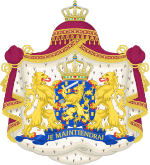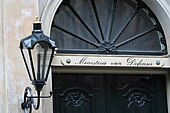Ministry of Defence (Netherlands)
This article needs additional citations for verification. (March 2015) |
| Ministerie van Defensie | |
 Logo of the Ministry of Defence | |
 Coat of arms of the Netherlands | |
 Ministry of Defence | |
| Department overview | |
|---|---|
| Formed | November 29, 1813 |
| Jurisdiction | Kingdom of the Netherlands |
| Headquarters | Plein 4, The Hague, Netherlands |
| Employees | 41,380 active duty 6,763 reserve forces 3,000 paramilitary 21,674 civilian staff[1] |
| Annual budget | €21,4 billion (2024)[2] |
| Minister responsible |
|
| Deputy Minister responsible |
|
| Department executives |
|
| Website | https://www.defensie.nl |
The Ministry of Defence (Dutch: Ministerie van Defensie; MinDef) is the Dutch ministry responsible for the armed forces of the Netherlands and veterans' affairs. The ministry was created in 1813 as the Ministry of War and in 1928 was combined with the Ministry of the Navy. After World War II in the ministries were separated again, in this period the Minister of War and Minister of the Navy were often the same person and the state secretary for the Navy was responsible for daily affairs of the Royal Netherlands Navy. In 1959 the ministries were merged once again. The ministry is headed by the Minister of Defence, currently Ruben Brekelmans,[3] assisted by the Chief of the Defence, Onno Eichelsheim.
| Part of the Politics series |
![Azure, billetty Or a lion with a coronet Or armed and langued Gules holding in his dexter paw a sword Argent hilted Or and in the sinister paw seven arrows Argent pointed and bound together Or. [The seven arrows stand for the seven provinces of the Union of Utrecht.] The shield is crowned with the (Dutch) royal crown and supported by two lions Or armed and langued gules. They stand on a scroll Azure with the text (Or) "Je Maintiendrai" (French for "I will maintain".)](http://upload.wikimedia.org/wikipedia/commons/thumb/8/8f/State_coat_of_arms_of_the_Netherlands.svg/150px-State_coat_of_arms_of_the_Netherlands.svg.png) |
|---|
|
|
Responsibilities
[edit]The ministry is responsible for:
- protecting the territory of the Kingdom of the Netherlands (which includes the Netherlands, Curaçao, Sint Maarten and Aruba) and her allies;
- protecting and enhancing the international legal system and stability;
- supporting civil authorities in maintaining order, in case of emergencies and in giving humanitarian aid, both national and international.
Organization
[edit]The ministry consists of the Minister (Ruben Brekelmans) and the State Secretary of Defence (Gijs Tuinman), the so-called Central Staff, the Netherlands Armed Forces and two supporting organisations.
The Central Staff of the ministry is led by the Secretary-General, the highest civil servant. The most important elements of the Central Staff are:
- several directorates for policy, personnel, materiel and finance
- the Defence Staff
- the Defence Audit Service
- the Security Authority
- the Military Intelligence and Security Service
- the Military Aviation Authority
The highest military official is the Chief of Defence (Dutch: Commandant der Strijdkrachten). He is a four-star general or admiral and controls the branches of the armed forces, which are organized in three operational commands:
- the Royal Netherlands Navy Command;
- the Royal Netherlands Army Command;
- the Royal Netherlands Air Force Command.
The fourth branch of service, the Royal Netherlands Marechaussee, is a gendarmerie force that falls directly under the Secretary-General.
The armed forces are supported by two civil organizations that reside under the Ministry of Defence:
- a Support Command (Dutch: Defensie Ondersteuningscommando); and
- the Command Materiel and IT (Dutch: Commando Materieel en IT).
The ministry employs around 70,000 civil and military personnel.
See also
[edit]References
[edit]- ^ (in Dutch) [1], Defensie, September 1, 2023
- ^ (in Dutch) [https://www.defensie.nl/onderwerpen/overdefensie/het-verhaal-van-defensie/financien
- ^ Defensie, Ministerie van (2017-10-26). "Minister of Defence - Central Staff - Defensie.nl". english.defensie.nl. Retrieved 2024-07-08.
External links
[edit]- (in Dutch) Ministerie van Defensie (Rijksoverheid)
- (in English) Ministry of Defence (Government)

